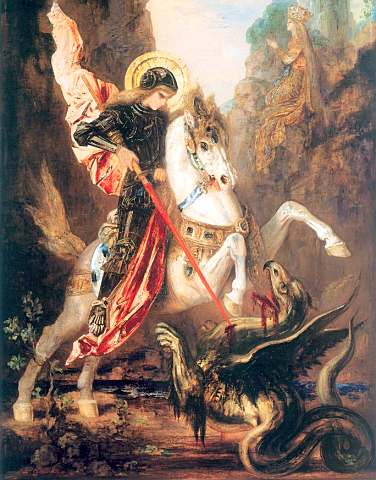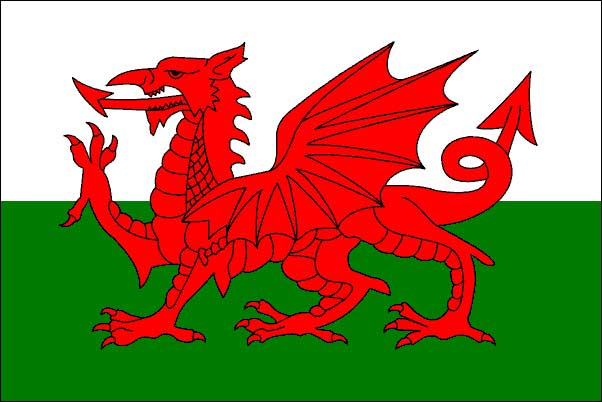|
|
| Home |Software | Web Games | Quizzes | Free for Teachers | About | Contact | Links |
|
|
Dragons
A dragon is a legendary creature, typically depicted as a large and powerful serpent or other reptile, with magical or spiritual qualities. The various figures now called dragons most likely have no single origin, but spontaneously came to be in several different cultures around the world, based loosely on the appearance of a snake and possibly fossilized dinosaur and Tertiary mammal megafauna remains. Chinese dragons (among others) or Long are generally seen as benevolent, whereas European dragons are usually malevolent. However, malevolent dragons are not restricted to Europe and also occur in Persian mythology and other cultures.

Saint George versus the dragon by Gustave Moreau, around 1880
Malevolent dragons are prominent figures in Christian belief. In Revelation 12:3, an enormous red dragon with seven heads is described, whose tail sweeps one third of the stars from heaven down to earth (held to be symbolic of the fall of the angels). The Latin word for a dragon, draco, actually means snake or serpent and is so connected to the Christian association of snakes and the Devil.
In medieval symbolism, dragons were often symbolic of apostasy and treachery, but also of anger and envy, and eventfully symbolized great calamity. Several heads were symbolic of decadence and oppression, and also of heresy. They also served as symbols for independence, leadership and strength. Colors often determined the symbolism a dragon carried. In the hero's journey pattern, dragons represented fear. Dragons are often held to have major spiritual significance in various religions and cultures around the world. In many oriental cultures dragons were, and in some cultures still are, revered as representative of the primal forces of nature and the universe.
In European mythology, a dragon is a serpent-like legendary creature. The Latin word draco, as in the constellation Draco, comes directly from Greek, drákōn. The word for dragon in Germanic mythology and its descendants is worm, meaning snake or serpent. In Old English wyrm means "serpent", draca means "dragon". Though a winged creature, the dragon is generally to be found in its underground lair, a cave that identifies it as an ancient creature of earth, like the mythic serpent, that was a source of knowledge even in Eden. Likely, the dragons of European and Mid Eastern mythology stem from the cult of snakes found in religions throughout the world.
Many modern stories represent dragons as extremely intelligent creatures who can talk, associated with (and sometimes in control of) powerful magic. Dragon's blood often has magical properties: for example it let Siegfried understand the language of the Forest Bird. The typical dragon protects a cavern filled with gold and treasure and is often associated with a great hero who tries to slay it, but dragons can be written in to a story in as many ways as a human character. This includes the monster being used as a wise being whom heroes could approach for help and advice.
It it is theorized that western dragons have descended from Roman dragons. Roman dragons evolved from serpentine Greek ones, combined with the dragons of Persia, in the mix that characterized the hybrid Greek/Eastern Hellenistic culture. The later Babylonian dragon worshiped by the court of the Persian Cyrus the Great, in the Hebrew narrative in Bel and the Dragon probably dates to the late 2nd century BCE. John's Book of Revelation — Greek literature, not Roman — describes Satan as "a great dragon, flaming red, with seven heads and ten horns". Much of John's literary inspiration is late Hebrew and Greek, but John's dragon, like his Satan, are both more likely to have come originally through Persia. Perhaps our distinctions between dragons of western origin and Chinese dragons are arbitrary.
Though the Latin is draco, draconis, it has been supposed by some scholars, including John Tanke of the University of Michigan, that the word dragon comes from the Old Norse draugr, which literally means a spirit who guards the burial mound of a king. How this image of a vengeful guardian spirit is related to a fire-breathing serpent is unclear. Many others assume the word dragon comes from the ancient Greek verb derkesthai, meaning "to see", referring to the dragon's legendarily keen eyesight. In any case, the image of a dragon as a serpent-like creature was already standard at least by the 8th century when Beowulf was written down. Although today we associate dragons almost universally with fire, in medieval legend the creatures were often associated with water, guarding springs or living near or under water.

Flag of Wales
Other European legends about dragons include "Saint George and the Dragon", in which a brave knight defeats a dragon holding a princess captive. This legend may be a Christianized version of the myth of Perseus, or of the mounted Phrygian god Sabazios vanquishing the chthonic serpent, but its origins are obscure. It is possible that the dragon legends of northwestern Europe are at least partly inspired by earlier stories from the Roman Empire, or from the Sarmatians and related cultures north of the Black Sea. There has also been speculation that dragon mythology might have originated from stories of large land lizards which inhabited Eurasia, or that the sight of giant fossil bones eroding from the earth may have inspired dragon myths.
Dragons are well-known in Catalan myths and legends, in no small part because St. George (Catalon Sant Jordi) is the patron saint of Catalonia. Like most dragons, the Catalan dragon (Catalan drac) is basically an enormous serpent with two legs, or rarely, four, and sometimes a pair of wings. As in many other parts of the world, the dragon's face may be like that of some other animal, such as a lion or bull. As is common elsewhere, Catalan dragons are fire-breathers, and the dragon-fire is all-consuming. Catalan dragons also can emit a fetid odor, which can rot away anything it touches.
The legend of Saint George and the dragon is well-known in Italy. But other Saints are depicted fighting a dragon. For instance, the first bishop of the city of Forlì, named Saint Mercurialis, killed a dragon and saved Forlì. So he often is depicted in the act of killing a dragon.